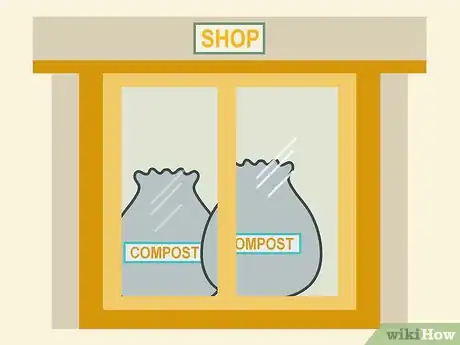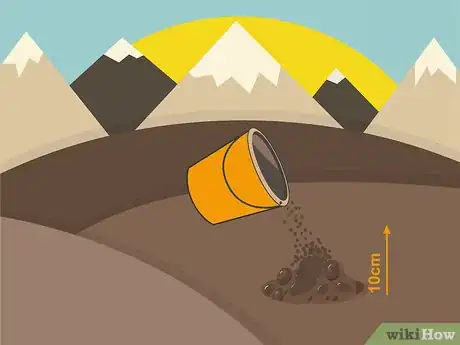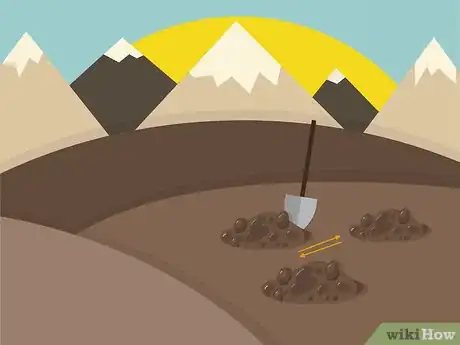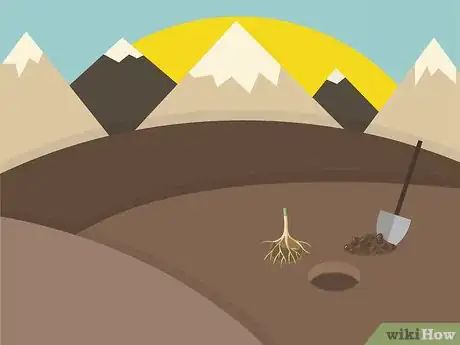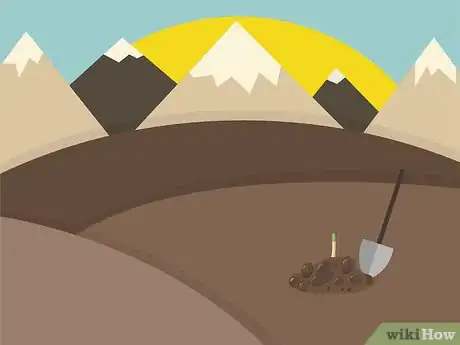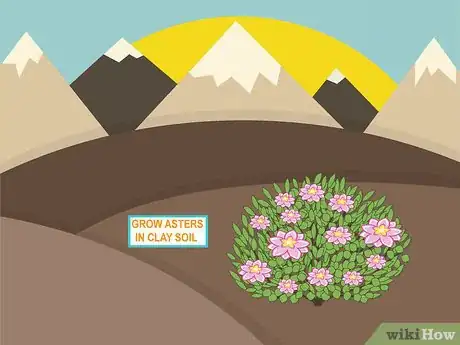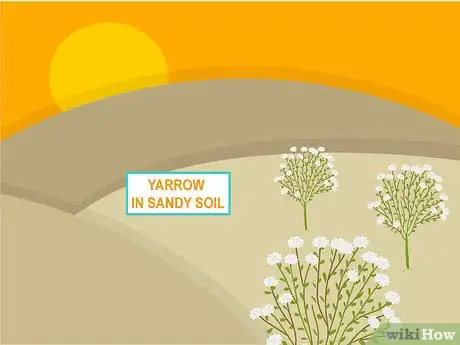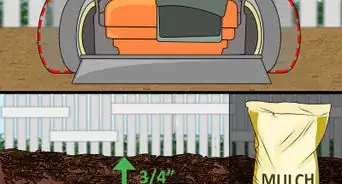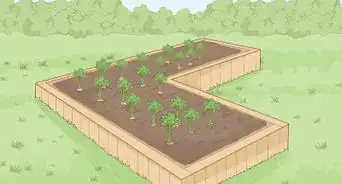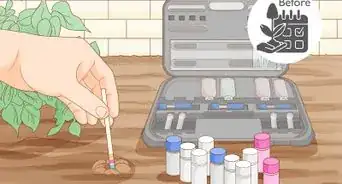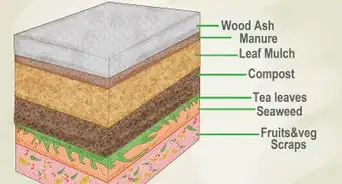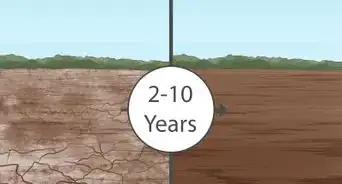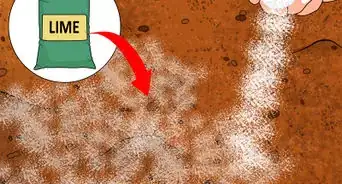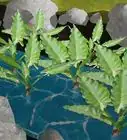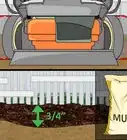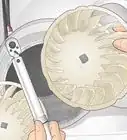This article was co-authored by Lauren Kurtz. Lauren Kurtz is a Naturalist and Horticultural Specialist. Lauren has worked for Aurora, Colorado managing the Water-Wise Garden at Aurora Municipal Center for the Water Conservation Department. She earned a BA in Environmental and Sustainability Studies from Western Michigan University in 2014.
There are 10 references cited in this article, which can be found at the bottom of the page.
This article has been viewed 42,778 times.
Whether you want to grow flowers, trees, or vegetables, plants can add natural beauty to your yard. However, planting and growing plants may not seem so simple if your yard doesn't have rich soil. Fortunately, there are several things you can do throughout the planting process to ensure that your plants thrive, including amending the soil with compost, planting the root ball properly, and/or choosing to plant specific plants that thrive in your particular soil type.
Steps
Amending the Soil
-
1Buy or make your own compost. The best way to improve your soil is to mix it with compost, as compost can make sand more water retentive and clay more porous. Make your own compost out of decaying organic matter, such as dead leaves or manure, or purchase some from a gardening store. Add in additional amendments to the compost if your soil has specific issues, such as a high or low pH level.[1]
- Add sand and pea gravel if the soil is too moist, dolomitic lime if it's too acidic, or elemental sulfur if it's too alkaline.[2]
- A soil pH kit can help you determine if your soil is alkaline or acidic. Most plants prefer a pH between 5.5 and 7. You can purchase soil pH kits at your local garden store or online.
-
2Spread 4–5 inches (10–13 cm) of organic matter overtop of the soil. The easiest way to do this is to put all of your compost into a large plastic bucket or a durable plastic bag. Pour the compost out of the bucket or bag onto the entire surface of the soil you want to plant in. Try to spread it out as evenly as possible.[3]Advertisement
-
3Use a shovel to turn over 10 in (25 cm)-deep sections of soil. Start at the edge of the compost-covered area. Place your foot on the step and and push the blade all the way into the ground. Then, lift up the soil and turn it over completely so that the poor soil is on top and the compost is beneath it. Do this everywhere that you spread the compost.[4]
- This can also be accomplished with a rototiller, which you can rent at your local home improvement store.
-
4Rake the surface flat. Pull a gardening rake across the surface of the soil in rows. This should help to mix the compost into the soil and also smooth out the surface of your planting area.[5]
Planting Your Plants
-
1Dig a hole that's as deep as the root ball. Dig a hole in your amended soil that's just as deep as your root ball is tall. This is necessary because your plant will adapt to the new environment and thrive best if its root ball is level with the ground. Also, make sure that the hole is slightly wider than your rootball is to ensure a proper fit.[6]
- If necessary, measure the root ball of your plant from top to bottom and side to side with a tape measure before you dig to ensure that the hole is the correct size.
-
2Remove the root ball from the container and squeeze the edges. While holding the plant with one hand, carefully pull the container off of the root ball with the other. Rough up the edges of the root ball by squeezing it in several different areas with your hands. This should help the plant adapt to its new environment.[7]
- If working with a larger plant, such as a tree, it may be better to lay your plant on its side or get a friend to help you at this point.
-
3Place the root ball in the hole and fill it the rest of the way with water. Lower the root ball into the hole and make sure that it's centered and straight. Turn on a hose or fill a watering can and fill the extra space in the hole with water. This should create a ring of water around the root ball between it and the ground.[8]
-
4Backfill the hole with soil. Push in all of the soil that you dug up when you dug the hole. Make sure that this soil is evenly spaced around the base of the plant to encourage adaptation and proper growth.[9]
Choosing Plants that Thrive in Poor Soil
-
1Grow asters or black-eyed susans in clay. If you have clay soil and you don't want to amend it, opt for plants that grow well in the soil as it is. Consider growing aster, as it adapts well and typically doesn't struggle to flourish in clay like other plants do. Black-eyed susans also do well in clay, and they grow and spread quickly. Go with black-eyed susans if you'd like a pop of yellow in your garden.
- Black-eyed susans grow best in zones 3-11, while asters grow best in zones 3-9.
-
2Go with a hackberry or hedge maple tree if you have clay soil. Either of these trees can be grown in a variety of soil types, including clay. Go for the hackberry if you want a tall tree that attracts wildlife and opt for a hedge maple if you'd prefer a hedge-like tree.[10]
-
3Go with yarrow or california poppies if you have sandy soil. Plant yarrow if you can provide full sun for it or california poppies if you'd like a vibrant variety of color in your garden. Both of these can grow and stay healthy in a soil that's mostly make up of sand.[11]
-
4Plant white pines or red cedars in dry, sandy soil. If your poor soil is of a sandy variety and you want to grow trees, you can do so without amending your soil. Opt for a red cedar if you have a smaller yard, and a white pine if you have a big space for it to grow in.[12]
- White pines often grow to be taller than 55 feet (17 m)!
-
5Choose bellflower or lavender for rocky soil. Both of these types of plants can flourish in poor, rocky soil. Skip the amendment process and plant bell flowers if you're willing to stay on top of frequent waterings. Plant some lavender instead if you can provide full sun.[13]
Community Q&A
-
QuestionI have read that it's necessary to break up compacted soil to a depth of 18", so your roots or bulbs can be buried 6" deep with 12" of loose soil below. Do you need to dig 18" deep first?
 Lauren KurtzLauren Kurtz is a Naturalist and Horticultural Specialist. Lauren has worked for Aurora, Colorado managing the Water-Wise Garden at Aurora Municipal Center for the Water Conservation Department. She earned a BA in Environmental and Sustainability Studies from Western Michigan University in 2014.
Lauren KurtzLauren Kurtz is a Naturalist and Horticultural Specialist. Lauren has worked for Aurora, Colorado managing the Water-Wise Garden at Aurora Municipal Center for the Water Conservation Department. She earned a BA in Environmental and Sustainability Studies from Western Michigan University in 2014.
Professional Gardener If your soil is heavily compacted, so for example a construction site, worn path, or really hard clay soil, digging 12” to 18” deep first is recommended. Be sure to mix in at least 3” to 6” of compost after you rototill in order to enrich the soil.
If your soil is heavily compacted, so for example a construction site, worn path, or really hard clay soil, digging 12” to 18” deep first is recommended. Be sure to mix in at least 3” to 6” of compost after you rototill in order to enrich the soil. -
QuestionDo I put the good soil on top of the soil that has the compost in it?
 Community AnswerYes, because most garden plants' roots grow on upper soil.
Community AnswerYes, because most garden plants' roots grow on upper soil.
Things You'll Need
- Store-bought compost or organic matter
- Sand (optional)
- Pea gravel (optional)
- Dolomitic lime (optional)
- Elemental sulfur (optional)
- Plastic bucket or bag
- Shovel
- Rake
- Root ball
- Tape measure (optional)
- Water
References
- ↑ https://www.sunset.com/garden/garden-basics/improving-soil-structure
- ↑ http://www.hobbyfarms.com/6-soil-problems-and-amendment-solutions-5/
- ↑ https://www.sunset.com/garden/garden-basics/improving-soil-structure
- ↑ https://www.sunset.com/garden/garden-basics/improving-soil-structure
- ↑ https://www.bhg.com/gardening/flowers/perennials/how-to-grow-healthy-plants/
- ↑ https://www.youtube.com/watch?v=ARwB7xb--sQ&feature=youtu.be&t=1m18s
- ↑ https://www.youtube.com/watch?v=ARwB7xb--sQ&feature=youtu.be&t=24s
- ↑ https://www.youtube.com/watch?v=ARwB7xb--sQ&feature=youtu.be&t=1m34s
- ↑ https://www.youtube.com/watch?v=ARwB7xb--sQ&feature=youtu.be&t=1m34s
- ↑ http://www.missouribotanicalgarden.org/gardens-gardening/your-garden/help-for-the-home-gardener/advice-tips-resources/visual-guides/ps-plants-for-clay-soil-trees.aspx
- ↑ http://www.birdsandblooms.com/gardening/gardening-basics/top-10-plants-sandy-soil/?7
- ↑ https://lancaster.unl.edu/hort/articles/2004/plantssandysoils.shtml
- ↑ http://www.birdsandblooms.com/gardening/top-10-lists-for-gardeners/top-10-plants-rocky-soil/?2
About This Article
The easiest way to plant in poor soil is by amending the soil. Before you plant, spread a 4 to 5 inch layer of compost on top of the soil, and use a tiller to mix in the compost. Alternatively, you can use a shovel to dig up the soil and mix in the compost. Then, rake the surface flat so that it’s level for planting. When choosing plants for your garden, select ones that grow well in poor conditions, such as asters or black-eyed susans. For more tips from our Horticulturist reviewer, including how to pick plants that will grow best in specific types of soil, scroll down!
